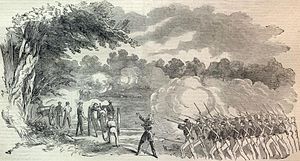Battle of Boonville
| First Battle of Boonville | |||||||
|---|---|---|---|---|---|---|---|
| Part of the American Civil War | |||||||
 The Battle of Boonville, Missouri, sketched by Orlando C. Richardson |
|||||||
|
|||||||
| Belligerents | |||||||
|
|
|
||||||
| Commanders and leaders | |||||||
| Nathaniel Lyon | John S. Marmaduke | ||||||
| Units involved | |||||||
|
1st MO & 2nd MO & 2nd U.S. Infantry, F, 2nd U.S. Artillery |
Missouri State Guard | ||||||
| Strength | |||||||
| 1,700 | ~1,500 | ||||||
| Casualties and losses | |||||||
|
5 killed or died of wounds 7 wounded |
5 killed or died of wounds 10 wounded 60-80 captured and paroled |
||||||
1st MO & 2nd MO & 2nd U.S. Infantry,
5 killed or died of wounds
5 killed or died of wounds 10 wounded
The First Battle of Boonville was a minor skirmish of the American Civil War, occurring on June 17, 1861, near Boonville in Cooper County, Missouri. Although casualties were extremely light, the battle's strategic impact was far greater than one might assume from its limited nature. The Union victory established what would become an unbroken Federal control of the Missouri River, and helped to thwart efforts to bring Missouri into the Confederacy.
Four battles were fought at Boonville during the Civil War: the first battle forms the main subject of this article, while the others are described below under other battles at Boonville.
At the onset of the Civil War, Missouri, like many border states in the Union, was deeply divided over whether to support the United States under Abraham Lincoln, or join the nascent Confederacy under Jefferson Davis. Claiborne F. Jackson, the pro-Southern governor, wanted his state to secede, but Missouri's overall sentiment was initially neutral. An elected State convention did not pass a secession ordinance, as Jackson had hoped it might.
However, pro-secession elements did not let this setback dissuade them. They seized the small Federal armory in Liberty, Missouri, planning to subsequently confiscate a much more sizable stock of weapons located at the St. Louis Arsenal. This plot was temporarily thwarted by an energetic young officer, Captain Nathaniel Lyon. Lyon allied himself with Missouri Congressman Frank Blair and anti-slavery German immigrants in St. Louis to secure the arsenal for the Union. In the process, Lyon used a mixed force of U.S. Army Regulars and Federally enrolled Missouri Volunteers (mostly ethnic Germans) to capture the Missouri Volunteer Militia (MVM) which had assembled (purportedly for an innocuous annual drill) at Camp Jackson on the outskirts of St. Louis on May 10, 1861.
...
Wikipedia
